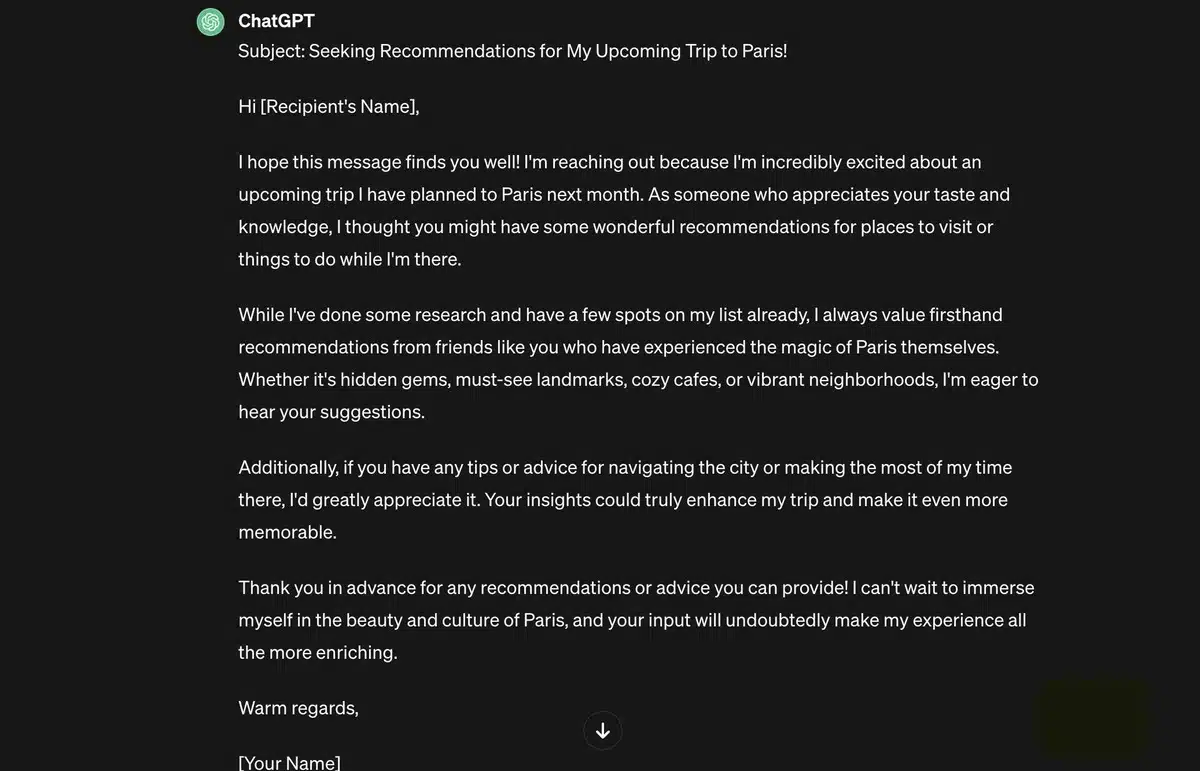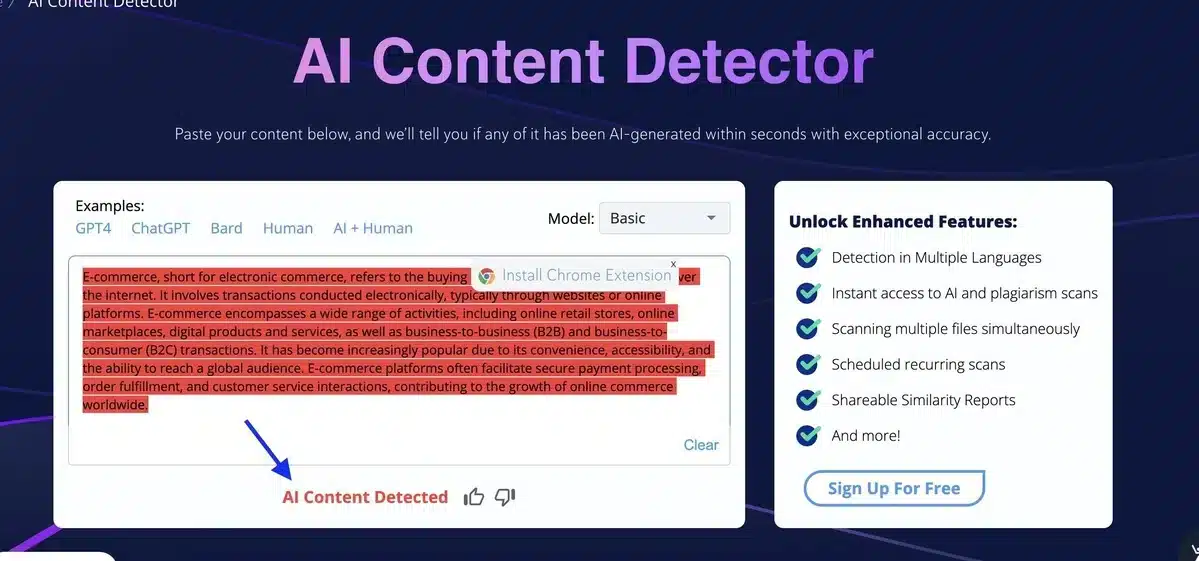How to Detect ChatGPT Content: Can You Spot the Difference?

Welcome to our blog, where we’ll explore the skill to detect ChatGPT content. In today’s digital world, it’s becoming increasingly important to distinguish between text created by humans and that generated by AI, like ChatGPT.
As technology advances, AI can produce content that closely resembles human writing.
We’ll look into practical methods to detect ChatGPT content, offering insights to help you confidently discern between computer-generated and human-authored text.
Whether you’re a content creator, consumer, or simply curious about AI, mastering the ability to detect ChatGPT content will empower you to navigate online platforms with clarity and assurance.
Table of Contents
Is it Wrong to Generate Content using ChatGPT?

While obtaining ChatGPT-generated content isn’t always bad, it is essential to consider how it is used.
Although ChatGPT might be helpful for writing and idea generation, complications can occur if the information is misused dishonestly.
It is crucial to develop techniques to detect ChatGPT content and guarantee its accuracy and fairness.
The possible effects on careers in creative fields should also be considered.
How to Detect ChatGPT Content
Detecting ChatGPT-generated content can be challenging, but there are some methods you can use:
1. Analyze Writing Style
Analyzing and assessing the writing styles is essential to detect ChatGPT content. ChatGPT frequently generates content that may lack human-like details.
Look for language, tone, or syntax errors indicating an AI created it.
Pay attention to overly formal or robotic language, repetitive structures, or strange word choices not found in natural human communication.
ChatGPT also may need help understanding idiomatic terms or slang that humans use.
For Example:
If I ask ChatGPT, “Write an asking message for me on a trip I am planning to Paris next month and asking for any recommendations on places to visit?“
The AI-generated content will be as follows:

But the Original human-written message will be as follows:
“Hey, I’m planning a trip to Paris next month. Any recommendations on places to visit?“
Which is in short and precise.
2. Check for Coherence
When you want to detect ChatGPT content, consider how well everything flows.
ChatGPT can create text that seems okay, but it might not always stick to the main topic or make sense all the way through.
Look for sudden changes in what’s being discussed or if things don’t fit together smoothly. Also, see if the ideas make sense and follow each other logically.
If it feels like things are jumping around or not connecting well, it could be a sign that ChatGPT was used.
So, by checking for coherence, you can determine if ChatGPT or a natural person likely made something.
For Example:

Explanation:
- The text begins with the narrator going to the store to buy apples, which is logical.
- However, it then contains an unrelated observation about a dog going after a squirrel, which breaks the narrative’s flow and appears out of context.
- The statement about missing the wallet introduces a fresh plot component but needs to flow more easily into the story.
- The ending of returning home to grab the wallet and then buying the apples brings closure, but it feels removed from the initial context of walking to the store.
3. Search for Keywords
When trying to detect ChatGPT content, pay close attention to the presence and usage of keywords.
ChatGPT may include uncommon or irrelevant keywords that stand out in the text.
Look for unusual phrases or words that seem out of place within the context of the content.
Additionally, ChatGPT-generated content might display repetitive or overly specific keyword usage, reflecting patterns in its training data.
By analyzing the choice and frequency of keywords, you can gather clues about the content’s origin and determine if it resembles typical human writing or exhibits characteristics of AI generation.
For Example:
Suppose you’re reviewing an article about artificial intelligence by an anonymous author.
As you read the text, you notice an unusual abundance of technical terms and phrases, such as “neural network architectures” and “backpropagation algorithms,” which seem out of place for a general audience article.
Additionally, you observe the repeated use of terms like “artificial intelligence” and “machine learning” in almost every paragraph, suggesting a pattern of keyword stuffing rather than natural language usage.
These clues lead you to suspect that the content may have been generated by ChatGPT rather than written by a human author.
4. Verify Facts
Fact-checking any information in the content suspected of being generated by ChatGPT is essential.
Since ChatGPT might not always provide accurate details, verifying facts is crucial. Compare claims or statistics with reliable sources to confirm their correctness.
Also, watch out for any information that seems unrealistic or lacks evidence.
If the content contains inaccuracies or questionable claims, it could indicate that ChatGPT created it.
For Example:
Assume you find an article online about a new scientific breakthrough that claims “people can now live up to 200 years thanks to advances in genetic engineering“.
The article includes detailed information and opinions from supposed experts on the topic. However, following closer investigation, the claims were exaggerated and unrealistic.
You decide to perform further research to confirm the facts and detect ChatGPT content.
You look for respected scientific journals, news outlets, and government institutions that cover human lifespan and genetic engineering.
After researching multiple trustworthy sources, you discover no evidence supporting the unbelievable claim that people can live for up to 200 years.
Based on the difference between the article’s claims and confirmed facts, it shows that ChatGPT may have generated the material.
5. Use AI Detection Tools
Detecting content created by ChatGPT can also be done by using special computer tools designed for this task.
Some known AI detection tools used to detect ChatGPT content are Copyleaks, Scribbr, Quillbot, etc. These tools learn from many examples to better recognize and detect ChatGPT content.

These tools are like innovative programs that analyze different parts of the text to see if it resembles content generated by ChatGPT.
They examine how sentences are structured, the words used, and if everything makes sense.
They compare the text you’re examining to known samples of ChatGPT-generated content to see if there are similarities.
These tools can indicate the likelihood that ChatGPT produced the content. While these tools aren’t perfect, they can assist in gaining insight into whether something was generated by ChatGPT or not.
6. Compare to Known Samples
Another method to detect ChatGPT content is by comparing it to known examples of text produced by ChatGPT.
This comparison allows you to look for similarities or differences in writing style.
Doing so lets you understand how ChatGPT typically generates text and what patterns it tends to follow.
This process is a reference point to determine if ChatGPT likely creates the content.
Ultimately, comparing suspected content to known ChatGPT samples helps improve your ability to identify instances of ChatGPT-generated content accurately.
For Example:
If you suspect that ChatGPT generated a blog post, you can compare it to other blogs written by humans. By examining factors such as writing style, tone, and complexity of ideas, you can identify any differences or inconsistencies that may indicate AI involvement.
If the suspected content lacks the personal touch, creativity, or depth of understanding typically found in human-authored posts, it could be a sign that ChatGPT was used to generate it.
Comparing the suspected content to known human-written samples can help determine if it will likely be ChatGPT-generated.
How to Generate AI Detection-Free Content from ChatGPT
To generate AI detection-free content from ChatGPT, follow these steps:
- Manual Review: After generating content with ChatGPT, carefully review it yourself. Look for any indications that AI may have developed the text, such as unnatural language, lack of logic, or inconsistencies.
- Human Touch: Add personal touches or unique elements into the content that are less likely to be replicated by AI. This could include anecdotes, personal experiences, or human thought and emotion details.
- Use ChatGPT Extensions: Various chatGPT extensions like AIPRM for ChatGPT help optimize your content and pass the AI Detection Test.
- Customization: Modify the content to your audience or purpose in a way that goes beyond what an AI could produce. Incorporate specific references, SEO, industry knowledge, or localized information that adds value and authenticity to the content.
- Originality: Ensure your original content is not directly lifted from AI-generated sources. Plagiarism detection tools can help verify the uniqueness of your content.
- Engage Others: Share your content with colleagues, friends, or trusted individuals for feedback. Human eyes and perspectives often spot nuances or inconsistencies that AI detection tools might miss.
- Mix Media: Combine text generated by ChatGPT with other media types, such as images, videos, or audio recordings, to create a more comprehensive and authentic content experience.
- Stay Informed: Stay updated on advancements in AI technology and detection methods to understand better how to create content less likely to be identified as AI-generated.
By following these strategies, you can generate content from ChatGPT that is less likely to be detected as AI-generated, maintaining authenticity and credibility in your communication efforts.
Final Thoughts on How to Detect ChatGPT Content
Understanding how to detect ChatGPT content is essential in today’s digital environment.
As AI technology grows, it is essential to distinguish between human-created and machine-generated information.
We can ensure the online information is trustworthy and genuine by thoroughly reviewing it, thinking carefully, and connecting with content writers.
Furthermore, staying current on AI breakthroughs and applying detection techniques can help us effectively identify ChatGPT content.
Mastering the ability to detect ChatGPT content allows us to make more informed decisions and maintain authenticity in our online interactions.
FAQs About How to Detect ChatGPT Content
Why is it essential to detect ChatGPT content?
Detecting ChatGPT content is essential for ensuring transparency and trustworthiness, especially when human-generated content is expected. It helps prevent misinformation, plagiarism, and deceptive practices.
How can businesses or platforms protect against the misuse of ChatGPT-generated content?
Businesses and platforms can implement content moderation systems that flag potentially AI-generated content for review, educate users about the existence of AI-generated text, and enforce policies against deceptive practices.
What role does context play in detecting ChatGPT content?
Context is crucial in detecting ChatGPT content, as the appropriateness and coherence of the text within its surrounding context can provide clues to its origin. For instance, ChatGPT responses may seem out of place in professional or technical discussions.
Can ChatGPT content mimic specific writing styles or personalities?
ChatGPT can be fine-tuned to copy different writing styles or personalities by training it on specific datasets or providing prompts that reflect those styles. This makes detection even more challenging as it can adapt to mimic various voices.
Can ChatGPT content be indistinguishable from human-generated content?
ChatGPT’s advanced capabilities enable it to produce compelling text that can be challenging to distinguish from human-authored content, especially in short-form or casual communication.




